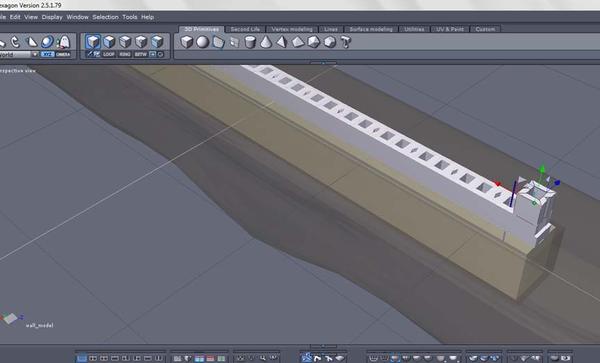Dealing with multiple units
 R1CH1
Posts: 80
R1CH1
Posts: 80
hey Daz,
so I'm building a model of a concrete wall. I understand I could have just made a rectangle and used a brick texture and been done with it. But I actually want to build the wall the way I would in life because I might.. It is 18x20 ft. Now obviously I need a way to manage something like 420 CMU blocks, Not to mention rebar. Hexagon has already been crashing on me. Does anyone have any suggestions? So far I've been copying the geometry.. should I be cloning or doing something else that creates less strain. also, when I am done with a few layers, I wouldn't mind merging some of it into one piece. But I'm not sure how. Do I have to go in and weld each vertex? Isn't there a merge or join object command?
thanks




Comments
if the geometry is just a flat square face of each block, that is functionally no different than just using a brick texture, just needlessly resource intensive, because rendering will essentially merge the vertices visually, creating no visual difference. you'd just be better off making a grid and assigning a single brick texture to each block.
but...
you use the multiple copies tool to make multiple copies of something, with whatever offsets are desired before validating the action.
the clone option is only good if you want to make changes to copies of something by altering the original.
you can weld copies together, but it's best to delete any faces that won't be viewed or that intersect with others, before making multiple copies, so things like top/bottom face can go.
I would use multiple copies to create 1 row of the desired length, then use it again on the row to make multiple copies of the row.
also make sure to UV map the single starting brick before doing any copying.
but again, bricks like that are functionally and visually useless to do this way. You can't see any spaces between them. You can just create a solid wall, and alter the top/sides or whatever to give the appearance of something like cynder blocks.
in image1, is an example of using the clone tool using the copy on support tool on a circle line to alter a singular part to get a desired effect and make the block fit properly. there is also an example of using multiple copies to create rows of blocks.
in image2 and image3, is an example of a single model from a grid. no multiple copies, no individual blocks. very efficient.
Fully agree that this is highly inefficient method - you could achieve the same result using a cube with texture and bump or normal maps.
However, if you do use that method for the heck of it, be aware that when you weld into a single object, touching edges will weld, resulting in non-manifold edges, which are seriously bad. See that attached pic - the one with the blue lines has those non-manifold edges - the other had the sides removed before replicating, welded then the two outer sides put back.
Of course, you can model the blocks so that when they are joined into a wall, they will give the appearance of having mortar between them:)
A far simple, more efficient method - make a grid, give it thickness, select all the edges, do "extract around", scale the original edges inwards.
It's a slow day here :)
...or even an offset brick pattern.
Really must go find something useful to do today :)